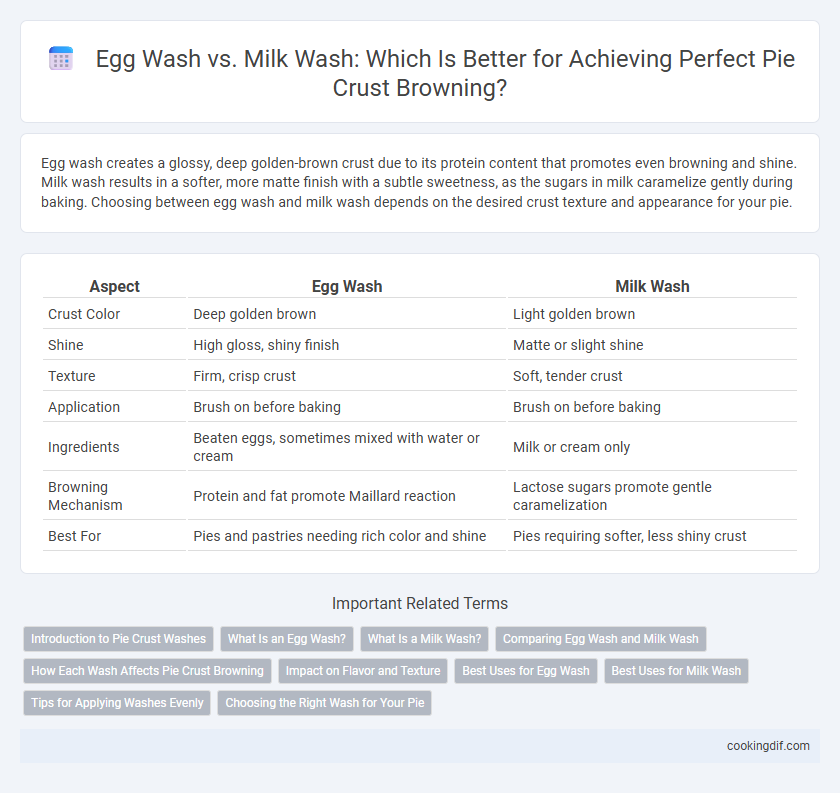Egg wash creates a glossy, deep golden-brown crust due to its protein content that promotes even browning and shine. Milk wash results in a softer, more matte finish with a subtle sweetness, as the sugars in milk caramelize gently during baking. Choosing between egg wash and milk wash depends on the desired crust texture and appearance for your pie.
Table of Comparison
| Aspect | Egg Wash | Milk Wash |
|---|---|---|
| Crust Color | Deep golden brown | Light golden brown |
| Shine | High gloss, shiny finish | Matte or slight shine |
| Texture | Firm, crisp crust | Soft, tender crust |
| Application | Brush on before baking | Brush on before baking |
| Ingredients | Beaten eggs, sometimes mixed with water or cream | Milk or cream only |
| Browning Mechanism | Protein and fat promote Maillard reaction | Lactose sugars promote gentle caramelization |
| Best For | Pies and pastries needing rich color and shine | Pies requiring softer, less shiny crust |
Introduction to Pie Crust Washes
Pie crust washes like egg wash and milk wash enhance the crust's color and texture by promoting browning during baking. Egg wash, made from beaten eggs or egg yolks, gives a glossy, rich golden finish and helps toppings adhere better. Milk wash, consisting of milk or cream, produces a softer, matte appearance with a subtle browning effect, ideal for a tender crust.
What Is an Egg Wash?
An egg wash is a mixture of beaten eggs, sometimes combined with water or milk, applied to pie crusts before baking to enhance browning and create a glossy finish. The proteins and fats in the egg wash promote Maillard reaction, resulting in a rich golden color and appealing texture. Egg wash often yields a more vibrant shine compared to milk wash, making it a popular choice for professional bakers aiming for a visually striking crust.
What Is a Milk Wash?
A milk wash is a simple mixture of milk applied to pie crusts before baking to enhance browning and create a tender, golden finish. Unlike egg wash, which gives a glossy and rich sheen, milk wash produces a softer crust color with a subtle shine and less pronounced gloss. The lactose and proteins in milk gently caramelize during baking, resulting in an evenly browned surface ideal for delicate pastries and pies.
Comparing Egg Wash and Milk Wash
Egg wash creates a glossy, rich golden-brown crust due to its protein and fat content, making pies visually appealing and slightly crispier. Milk wash produces a softer, matte finish with a subtle browning effect, ideal for a tender crust texture. Choosing between egg wash and milk wash depends on the desired crust appearance and texture for the pie.
How Each Wash Affects Pie Crust Browning
Egg wash creates a glossy, deep golden-brown crust due to the proteins and fats in the egg promoting Maillard browning and caramelization. Milk wash results in a softer, lighter brown crust with a slight sheen, as the sugars and proteins in milk contribute to gentle browning without intense gloss. Understanding these differences helps bakers choose the ideal wash for desired pie crust texture and appearance.
Impact on Flavor and Texture
Egg wash creates a glossy, golden-brown crust with a slightly richer flavor due to its protein and fat content, enhancing both taste and texture. Milk wash produces a softer, less shiny crust with a subtle sweetness from lactose, resulting in a tender bite rather than crispness. Choosing egg wash or milk wash directly influences the pie crust's final appearance, flavor profile, and mouthfeel.
Best Uses for Egg Wash
Egg wash, composed of beaten eggs or eggs combined with water or milk, produces a rich, glossy crust that is ideal for pastries requiring a deep, golden-brown finish, such as pies and tarts. Its high protein and fat content enhance browning through Maillard reactions, creating a more pronounced color and sheen compared to milk wash. Egg wash is best used on fruit pies, savory hand pies, and puff pastries where a visually appealing, durable crust is desired.
Best Uses for Milk Wash
Milk wash is ideal for achieving a soft, golden-brown pie crust with a subtle shine, enhancing the appearance without overpowering the natural flavors. Its moderate sugar and protein content promote even browning and a tender texture, especially suited for fruit pies and cream pies. Using milk wash on a pie crust helps create an inviting finish while maintaining a delicate, appetizing crust surface.
Tips for Applying Washes Evenly
For even crust browning, apply egg wash with a soft pastry brush in thin, consistent layers to avoid pooling and sogginess. When using milk wash, brush lightly and ensure the surface is dry to enhance golden color without blotches. Maintain steady, gentle strokes and allow the wash to set briefly before baking to achieve a uniform finish.
Choosing the Right Wash for Your Pie
Applying the right wash significantly impacts pie crust browning, with egg wash providing a glossy, rich golden finish due to its protein and fat content. Milk wash, containing lactose and proteins, offers a softer, matte look and encourages even browning without excessive shine. Selecting between egg wash and milk wash depends on desired crust texture and appearance, with egg wash favored for a vibrant sheen and milk wash chosen for a tender, understated crust.
Egg wash vs milk wash for crust browning Infographic

 cookingdif.com
cookingdif.com